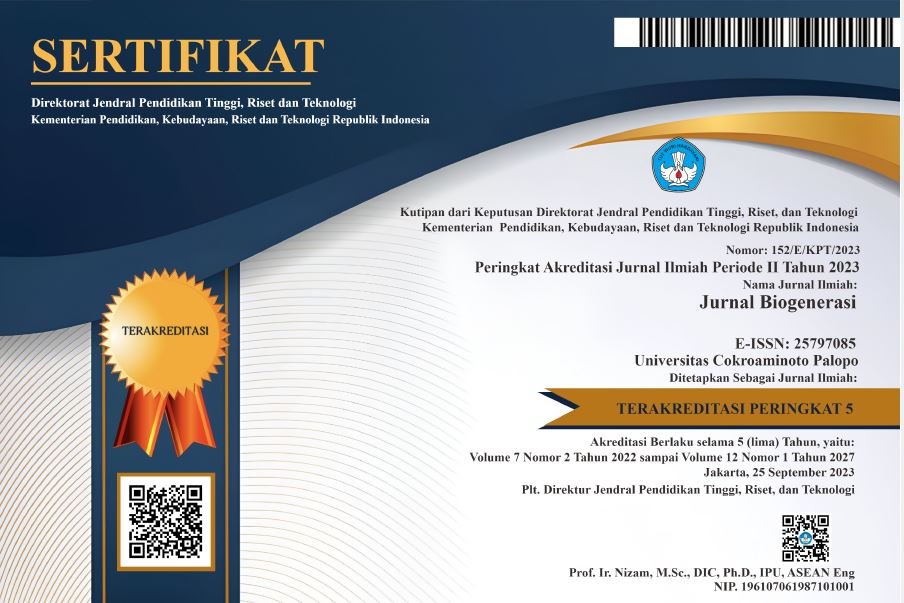REVIEW: PRODUKSI LIMONENE MELALUI REKAYASA JALUR PENTOSA FOSFAT MENGGUNAKAN CYANOBACTERIUM Synechocystis sp. PCC 6803
DOI:
https://doi.org/10.30605/biogenerasi.v10i2.5344Keywords:
metabolic engineering, isoprene, limonene synthase, citrus, microorganismsAbstract
Limonene, a terpenoid compound found in various plants such as oranges, lemons, and mint, has numerous applications in different industrial fields, including as a fragrance, flavoring agent, and biofuel. Conventional limonene production relies on agricultural outputs vulnerable to fluctuations caused by diseases or climate change. Therefore, metabolic engineering using microorganisms offers an interesting alternative for more efficient and sustainable limonene production. This review article aims to summarize the procedures for limonene production through the modification of the pentose phosphate (PP) and methylerythritol 4-phosphate (MEP) biosynthetic pathways in the cyanobacterium Synechocystis sp. PCC 6803 to produce limonene. Limonene synthase (lims) obtained from C. limon and M. spicata plants was cloned and transformed into cyanobacteria to enhance limonene production. Experimental results showed that genes associated with the limonene biosynthesis pathway, including ribose 5-phosphate isomerase (rpi), ribulose 5-phosphate 3-epimerase (rpe), and geranyl diphosphate synthase (gpps), were successfully expressed in Synechocystis. This study demonstrates that Synechocystis can be an efficient microbial system for limonene and other isoprene compound production, offering a more stable and environmentally friendly alternative than agricultural-based production.
Downloads
References
Angermayr, S. A., Rovira, A. G., & Hellingwerf, K. J. (2015). Metabolic engineering of cyanobacteria for the synthesis of commodity products. Trends in Biotechnology, 33(6), 352–361. https://doi.org/10.1016/j.tibtech.2015.03.009
Behrendorff, J. B., Vickers, C. E., Chrysanthopoulos, P., & Nielsen, L. K. (2013). 2,2-Diphenyl-1-picrylhydrazyl as a screening tool for recombinant monoterpene biosynthesis. Microbial Cell Factories, 12(1). https://doi.org/10.1186/1475-2859-12-76
Bentley, F. K., García-Cerdán, J. G., and Chen, H.-C. (2013). Paradigm of monoterpene (β-phellandrene) hydrocarbons production via photosynthesis in cyanobacteria. Bioenerg. Res. 6, 917–929. https://10.1007/s12155-013-9325-4
Bentley, F. K., and Melis, A. (2012). Diffusion-based process for carbon dioxide uptake and isoprene emission in gaseous/aqueous two-phase photobioreactors by photosynthetic microorganisms. Biotechnol. Bioeng. 109, 100–109. https://doi.10.1002/bit.23298
Burnham, Paul M. (2017). Limonene - Molecule of the Month March 2008 [Archived version]. figshare. Journal contribution. https://doi.org/10.6084/m9.figshare.5427154.v1
Chuck, C. J. &. D. J. (2014). The compatibility of potential bioderived fuels with Jet A-1 aviation kerosene. ideas.repec.org. https://ideas.repec.org/a/eee/appene/v118y2014icp83-91.html
Ciriminna, R., Lomelí-Rodríguez, M., Carà, P. D., Lopez-Sanchez, J. A., & Pagliaro, M. (2014). Limonene: a versatile chemical of the bioeconomy. https://www.semanticscholar.org/paper/Limonene%3A-a-versatile-chemical-of-the-bioeconomy.-Ciriminna-Lomel%C3%AD-Rodr%C3%ADguez/54a7ce45ddfe78844ff0f50e6d957680bde6f6a7
Davies, F. K., Work, V. H., Beliaev, A. S., & Posewitz, M. C. (2014). Engineering Limonene and Bisabolene Production in Wild Type and a Glycogen-Deficient Mutant of Synechococcus sp. PCC 7002. Frontiers in Bioengineering and Biotechnology, 2. https://doi.org/10.3389/fbioe.2014.00021
Erasto, P., & Viljoen, A. M. (2008). Limonene - A review: Biosynthetic, Ecological and pharmacological Relevance. Natural Product Communications, 3(7). https://doi.org/10.1177/1934578x0800300728
Ershov, Y. V., Gantt, R. R., Cunningham, F. X., & Gantt, E. (2002). Isoprenoid Biosynthesis in Synechocystis sp. Strain PCC6803 Is Stimulated by Compounds of the Pentose Phosphate Cycle but Not by Pyruvate or Deoxyxylulose-5-Phosphate. Journal of Bacteriology, 184(18), 5045–5051. https://doi.org/10.1128/jb.184.18.5045-5051.2002
Flamini, G., Tebano, M., & Cioni, P. L. (2007). Volatiles emission patterns of different plant organs and pollen of Citrus limon. Analytica Chimica Acta, 589(1), 120–124. https://doi.org/10.1016/j.aca.2007.02.053
Halfmann, C., Gu, L., & Zhou, R. (2014). Engineering cyanobacteria for the production of a cyclic hydrocarbon fuel from CO2and H2O. Green Chemistry, 16(6), 3175–3185. https://doi.org/10.1039/c3gc42591f
Hodges, A. W., Spreen, T. H. (2012). Economic impacts of Citrus greening (HLB) in Florida, 2006/07–2010/11. Institute of Food and Agricultural Sciences, University of Florida, Document No. FE903
Jahandideh, A., Johnson, T. J., Esmaeili, N., Johnson, M. D., Richardson, J. W., Muthukumarappan, K., Anderson, G. A., Halfmann, C., Zhou, R., & Gibbons, W. R. (2017). Life cycle analysis of a large-scale limonene production facility utilizing filamentous N2-fixing cyanobacteria. Algal Research, 23, 1–11. https://doi.org/10.1016/j.algal.2017.01.001
Johnson, T. J., Jahandideh, A., Johnson, M. D., Fields, K. H., Richardson, J. W., Muthukumarappan, K., Cao, Y., Gu, Z., Halfmann, C., Zhou, R., & Gibbons, W. R. (2016). Producing next-generation biofuels from filamentous cyanobacteria: An economic feasibility analysis. Algal Research, 20, 218–228. https://doi.org/10.1016/j.algal.2016.10.020
Jongedijk, E., Cankar, K., Buchhaupt, M., Schrader, J., Bouwmeester, H., & Beekwilder, J. (2016). Biotechnological production of limonene in microorganisms. Applied Microbiology and Biotechnology, 100(7), 2927–2938. https://doi.org/10.1007/s00253-016-7337-7
Khanijou, J. K., Hee, Y. T., Scipion, C. P. M., Chen, X., & Selvarajoo, K. (2024). Systems biology approach for enhancing limonene yield by re-engineering Escherichia coli. Npj Systems Biology and Applications, 10(1). https://doi.org/10.1038/s41540-024-00440-7
Kong, X., Wu, Y., Yu, W., Liu, Y., Li, J., Du, G., Lv, X., & Liu, L. (2023). Efficient Synthesis of Limonene in Saccharomyces cerevisiae Using Combinatorial Metabolic Engineering Strategies. Journal of Agricultural and Food Chemistry, 71(20), 7752–7764. https://doi.org/10.1021/acs.jafc.3c02076
Kiyota, H., Okuda, Y., Ito, M., Hirai, M. Y., & Ikeuchi, M. (2014). Engineering of cyanobacteria for the photosynthetic production of limonene from CO2. Journal of Biotechnology, 185, 1–7. https://doi.org/10.1016/j.jbiotec.2014.05.025
Lindberg, P., Park, S., and Melis, A. (2010). Engineering a platform for photosynthetic isoprene production in cyanobacteria, using Synechocystis as the model organism. Metab. Eng. 12, 70–79. https://doi.10.1016/j.ymben.2009.10.001
Lin, P., Saha, R., Zhang, F., & Pakrasi, H. B. (2017). Metabolic engineering of the pentose phosphate pathway for enhanced limonene production in the cyanobacterium Synechocysti s sp. PCC 6803. Scientific Reports, 7(1). https://doi.org/10.1038/s41598-017-17831-y
Muraleedharan, A., Sha, K., Kumar, S., Usha, G., Karthikeyan, P., Kumar, C. P. S., & Joshi, J. (2021). Response of Orchid Cut Flowers as Affected by Floral Preservatives on The Postharvest Quality. Plant Archives, 21(Suppliment-1), 1608–1620. Https://doi.org/10.51470/plantarchives.2021.v21.s1.254
Shahbazi, Y., & Shavisi, N. (2021). Chapter 4 - Limonene. In M. Mushtaq & F. Anwar (Eds.), A Centum of Valuable Plant Bioactives (pp. 77–91). Academic Press. https://doi.org/10.1016/C2019-0-04618-3
Soković, M., Glamočlija, J., Marin, P. D., Brkić, D., & Van Griensven, L. J. L. D. (2010). Antibacterial effects of the essential oils of commonly consumed medicinal herbs Using an in vitro model. Molecules, 15(11), 7532–7546. https://doi.org/10.3390/molecules15117532
Tracy, N. I., Chen, D., Crunkleton, D. W. & Price, G. L. (2009). Hydrogenated monoterpenes as diesel fuel additives. Fuel, 88 (11): 2238–2240. https://doi.org/10.1016/j.fuel.2009.02.002
Tranchida, P. Q., Zoccali, M., Bonaccorsi, I., Dugo, P., Mondello, L., & Dugo, G. (2013). The off-line combination of high performance liquid chromatography and comprehensive two-dimensional gas chromatography–mass spectrometry: A powerful approach for highly detailed essential oil analysis. Journal of Chromatography A, 1305, 276–284. https://doi.org/10.1016/j.chroma.2013.07.042
Zhang, X., Liu, X., Meng, Y., Zhang, L., Qiao, J., & Zhao, G. (2021). Combinatorial engineering of Saccharomyces cerevisiae for improving limonene production. Biochemical Engineering Journal, 176, 108155. https://doi.org/10.1016/j.bej.2021.108155
Downloads
Published
How to Cite
Issue
Section
License
In submitting the manuscript to the journal, the authors certify that:
- They are authorized by their co-authors to enter into these arrangements.
- The work described has not been formally published before, except in the form of an abstract or as part of a published lecture, review, thesis, or overlay journal.
- That it is not under consideration for publication elsewhere,
- That its publication has been approved by all the author(s) and by the responsible authorities – tacitly or explicitly – of the institutes where the work has been carried out.
- They secure the right to reproduce any material that has already been published or copyrighted elsewhere.
- They agree to the following license and copyright agreement.
License and Copyright Agreement
Authors who publish with this journal agree to the following terms:
- Authors retain copyright and grant the journal right of first publication with the work simultaneously licensed under Creative Commons Attribution License (CC BY 4.0) that allows others to share the work with an acknowledgment of the work's authorship and initial publication in this journal.
- Authors are able to enter into separate, additional contractual arrangements for the non-exclusive distribution of the journal's published version of the work (e.g., post it to an institutional repository or publish it in a book), with an acknowledgment of its initial publication in this journal.
- Authors are permitted and encouraged to post their work online (e.g., in institutional repositories or on their website) prior to and during the submission process, as it can lead to productive exchanges, as well as earlier and greater citation of published work.


.png)

